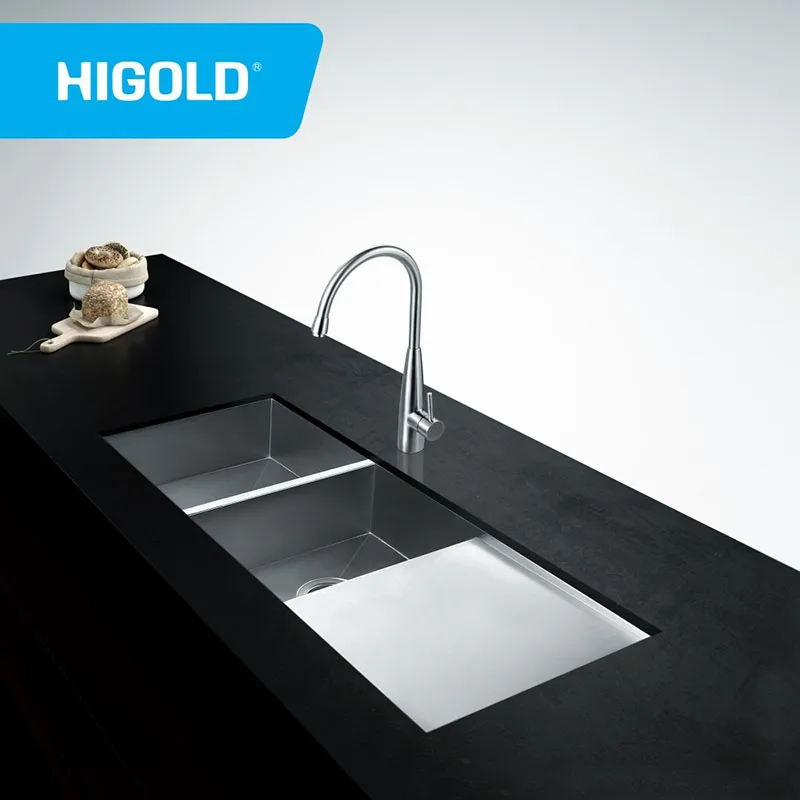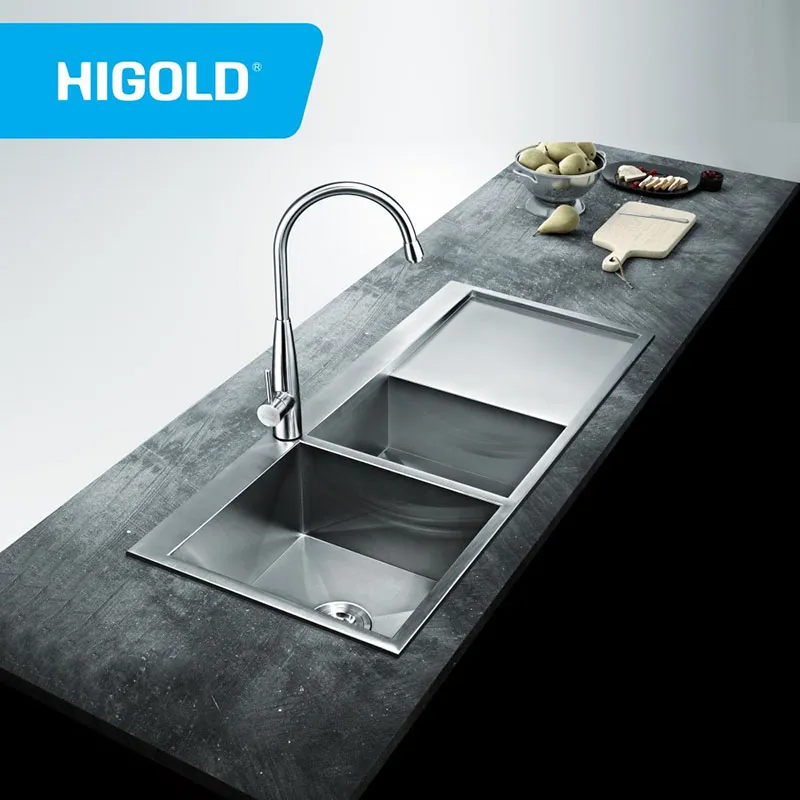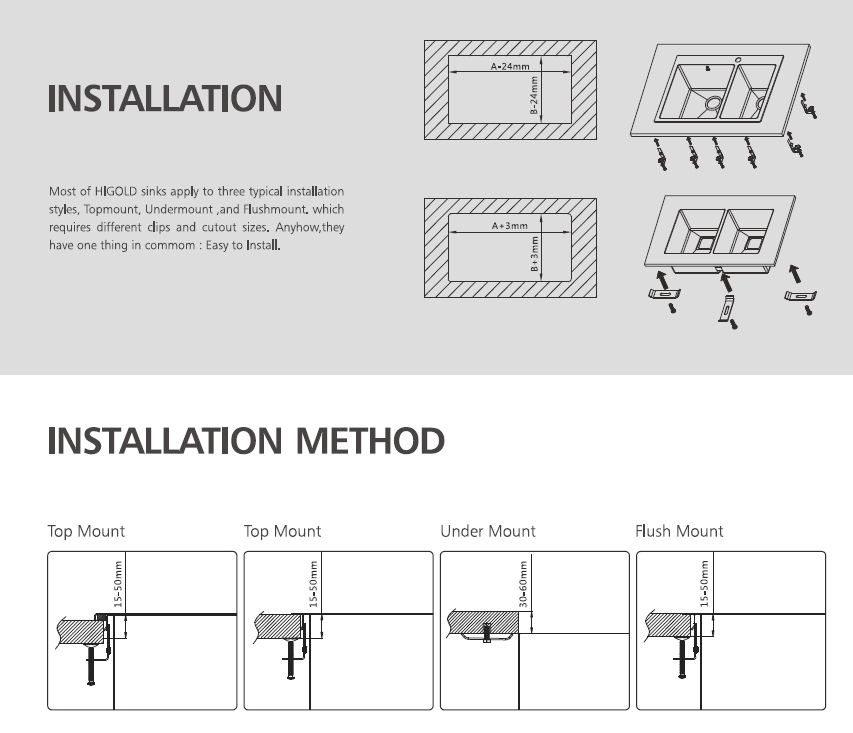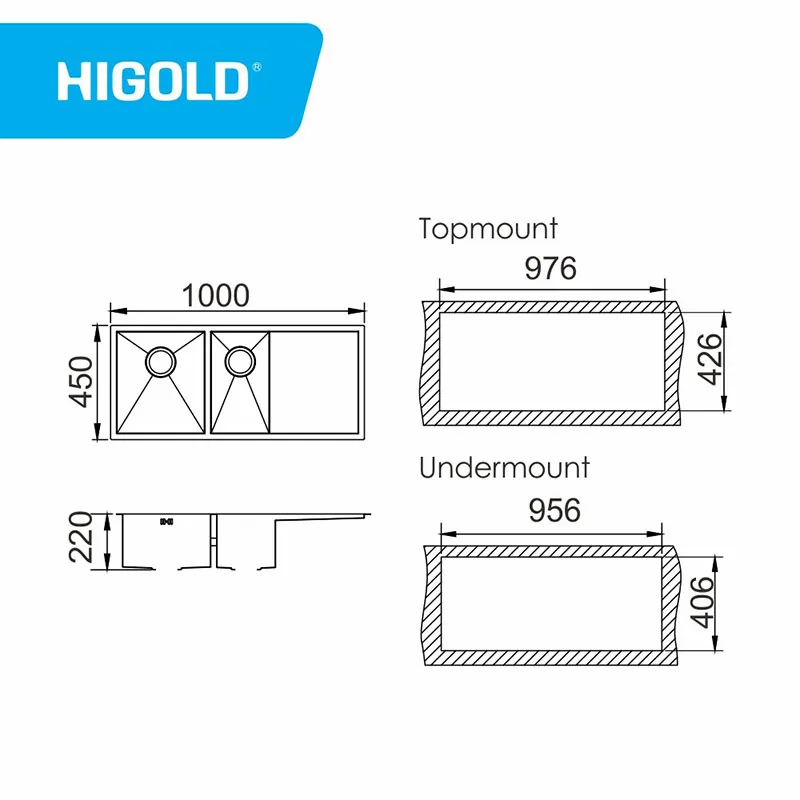With increasingly personalized kitchen designs, sink types are becoming increasingly diverse. Undermount kitchen sinks and topmount sinks are the two most common designs. While they may appear similar, they actually differ in many aspects, including installation method, design, cleaning difficulty, and functionality.
When choosing between an undermount sink and a topmount sink, consumers often struggle with the choice. The pros and cons of each need to be weighed based on their specific kitchen needs.
This article will detail the differences between undermount and topmount sinks, exploring their respective advantages and disadvantages to help consumers make an informed choice.
What is an undermount kitchen sink?
An undermount kitchen sink is a sink installed below the countertop. Unlike traditional above-the-counter sinks, the top edge of an undermount sink is completely concealed beneath the countertop, leaving it unobstructed. The key advantage of this installation method is the seamless connection between the sink edge and the countertop, resulting in a cleaner, more aesthetically pleasing countertop and easier cleaning.
Undermount sinks typically need to match the countertop material, such as quartz, granite, agate, or other stone or engineered stone. Installation requires a certain level of skill, as the sink rim must be securely fastened to the countertop to ensure stability and prevent water leaks.

What is a topmount sink?
A topmount sink has an exposed rim, typically recessed into the countertop and supported directly by the rim. This traditional installation method is relatively simple, and the exposed rim often creates a more solid appearance. Topmount sinks are suitable for a variety of countertop materials, including stainless steel, tile, and synthetic materials.
Undermount sinks are easier to install, adapting to a wider range of countertop materials and thicknesses without the delicate cutting and fastening required for undermount sinks.

Which is better, an undermount sink or a topmount sink? – Pros and Cons Comparison
After comparing the two sink types, we will now provide a detailed analysis of their pros and cons from multiple perspectives to help consumers make an informed decision.
1. Undermount vs. Topmount Sink: Appearance and Aesthetics
One of the most striking features of an undermount kitchen sink is its simple appearance. The top edge of the sink is hidden beneath the countertop, seamlessly blending into the surface, creating a smoother, more streamlined look. This design is ideal for kitchens pursuing a minimalist and modern aesthetic. Especially when paired with countertop materials like quartz or granite, it can create a high-end, elegant kitchen atmosphere.
In contrast, top-mount sinks are more traditional in design, with the sink edge often exposed, creating a noticeable seam and a somewhat abrupt overall effect. If your overall kitchen design leans towards a minimalist, modern style, an undermount sink may be more appealing. Top-mount sinks, on the other hand, are more suitable for those who prefer a more traditional design or for families with a more classic kitchen style.
2. Undermount vs. Topmount Sinks: Cleaning Ease
Undermount kitchen sinks offer a clear advantage when it comes to cleaning. Because the top edge of the sink is hidden beneath the countertop, water and food debris can easily flow down the countertop into the sink, preventing dirt and bacteria from accumulating between the sink and the countertop. When cleaning, users don't have to worry about stains accumulating at the seam between the sink and the countertop, making wiping easy. Furthermore, the sleek design of an undermount sink makes cleaning easier.
Topmount sinks, on the other hand, have exposed edges, which can easily collect water stains, food debris, and dirt. Cleaning the edges and seams may require a brush. This type of sink is relatively tedious to clean, especially after prolonged use, when accumulating water and dirt around the edges can be even more challenging.
3. Undermount vs. Topmount Sinks: Installation Difficulty
Undermount kitchen sinks are relatively complex to install. Because the sink is installed below the countertop, ensuring a tight fit between the sink and the countertop is essential to prevent leaks. Furthermore, different countertop materials require specialized glue to ensure the sink's stability. Therefore, undermount sink installation typically requires a professional installer to ensure quality.
In contrast, topmount sinks are relatively simple to install. Installation simply requires the sink to be recessed into the countertop, with the rim supported by the countertop. Whether stainless steel or other sink materials, top-mount sinks are easier to install, making them more suitable for DIY enthusiasts.
4. Undermount vs. Top-mount Sinks: Durability and Maintenance
From the perspective of durability and maintenance, undermount kitchen sinks offer superior performance. Because their installation method minimizes the seam between the sink and the countertop, reducing the potential for dirt accumulation, they require relatively little maintenance during daily use. Undermount sinks are also inherently more durable, especially when made of high-quality stainless steel or quartz, which effectively resists scratches and corrosion.
While top-mount sinks can also be made of stainless steel, their exposed edges are susceptible to wear and corrosion over time. Furthermore, accumulated water and dirt can easily accumulate around the edges, potentially affecting the sink's lifespan and appearance, necessitating regular maintenance.
5. Undermount vs. Top-mount Sinks: Adaptability and Flexibility
Top-mount sinks offer greater adaptability. Because top-mount sinks are simple to install, they can accommodate countertops of varying thicknesses, not just stone or composite materials. They can also be paired with ordinary wood and tile countertops. In contrast, undermount sinks have more complex installation requirements, especially regarding countertop material and thickness. Therefore, careful consideration must be given to the countertop structure and sink compatibility during installation.

How to Choose an Undermount Kitchen Sink vs. a Topmount Sink
Choosing between an undermount kitchen sink and a topmount sink depends on your kitchen's specific needs, budget, and personal design preferences. Here are some suggestions:
• Budget: If you have a more relaxed budget and prefer a modern, minimalist kitchen design, an undermount sink can be an option. It adds a touch of sophistication and aesthetics while also making cleaning easier. If you have a limited budget and aren't overly particular about appearance, a topmount sink can be a better choice, offering relatively low installation and maintenance costs.
• Kitchen Style: If your kitchen is modern and minimalist, an undermount sink may be more suitable. On the other hand, if you prefer a traditional kitchen design or have a smaller kitchen space, a topmount sink may be more suitable.
• Installation Requirements: For homes with specific installation requirements or those seeking a higher standard, an undermount kitchen sink is an ideal choice. However, if your kitchen requires more flexible and convenient installation, a topmount sink would be a better option.

Why should I choose Higold over other kitchen sink manufacturers in China?
Higold combines large-scale automated production, a strong R&D team, international certifications, and award-winning designs. The company offers factory-direct pricing, customization, and a proven track record of supplying major retailers globally. Buyers who prioritize quality, innovation, and dependable supply consistently choose Higold as their long-term partner.


